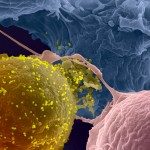Lien vers Pubmed [PMID] – 22205970
PLoS ONE 2011;6(12):e28795
BACKGROUND: Entamoeba histolytica is an important parasite of the human intestine. Its life cycle is monoxenous with two stages: (i) the trophozoite, growing in the intestine and (ii) the cyst corresponding to the dissemination stage. The trophozoite in the intestine can live as a commensal leading to asymptomatic infection or as a tissue invasive form producing mucosal ulcers and liver abscesses. There is no animal model mimicking the whole disease cycle. Most of the biological information on E. histolytica has been obtained from trophozoite adapted to axenic culture. The reproduction of intestinal amebiasis in an animal model is difficult while for liver amebiasis there are well-described rodent models. During this study, we worked on the assessment of pigs as a new potential model to study amebiasis.
METHODOLOGY/PRINCIPAL FINDINGS: We first co-cultured trophozoites of E. histolytica with porcine colonic fragments and observed a disruption of the mucosal architecture. Then, we showed that outbred pigs can be used to reproduce some lesions associated with human amebiasis. A detailed analysis was performed using a washed closed-jejunal loops model. In loops inoculated with virulent amebas a severe acute ulcerative jejunitis was observed with large hemorrhagic lesions 14 days post-inoculation associated with the presence of the trophozoites in the depth of the mucosa in two out four animals. Furthermore, typical large sized hepatic abscesses were observed in the liver of one animal 7 days post-injection in the portal vein and the liver parenchyma.
CONCLUSIONS: The pig model could help with simultaneously studying intestinal and extraintestinal lesion development.


